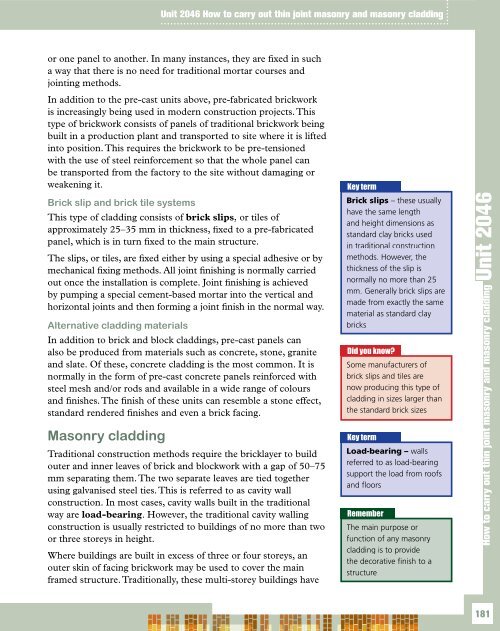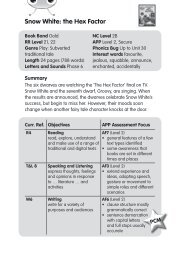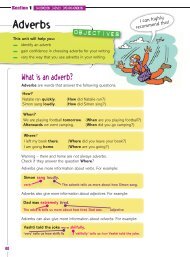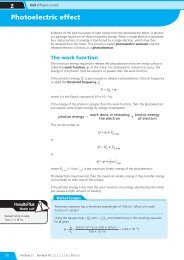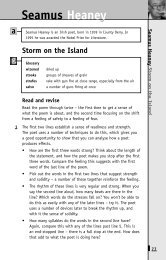Unit 2046 - Brickwork Level 2 CAA Diploma ... - Pearson Schools
Unit 2046 - Brickwork Level 2 CAA Diploma ... - Pearson Schools
Unit 2046 - Brickwork Level 2 CAA Diploma ... - Pearson Schools
You also want an ePaper? Increase the reach of your titles
YUMPU automatically turns print PDFs into web optimized ePapers that Google loves.
<strong>Unit</strong> <strong>2046</strong> How to carry out thin joint masonry and masonry cladding<br />
or one panel to another. In many instances, they are fixed in such<br />
a way that there is no need for traditional mortar courses and<br />
jointing methods.<br />
In addition to the pre-cast units above, pre-fabricated brickwork<br />
is increasingly being used in modern construction projects. This<br />
type of brickwork consists of panels of traditional brickwork being<br />
built in a production plant and transported to site where it is lifted<br />
into position. This requires the brickwork to be pre-tensioned<br />
with the use of steel reinforcement so that the whole panel can<br />
be transported from the factory to the site without damaging or<br />
weakening it.<br />
Brick slip and brick tile systems<br />
This type of cladding consists of brick slips, or tiles of<br />
approximately 25–35 mm in thickness, fixed to a pre-fabricated<br />
panel, which is in turn fixed to the main structure.<br />
The slips, or tiles, are fixed either by using a special adhesive or by<br />
mechanical fixing methods. All joint finishing is normally carried<br />
out once the installation is complete. Joint finishing is achieved<br />
by pumping a special cement-based mortar into the vertical and<br />
horizontal joints and then forming a joint finish in the normal way.<br />
Alternative cladding materials<br />
In addition to brick and block claddings, pre-cast panels can<br />
also be produced from materials such as concrete, stone, granite<br />
and slate. Of these, concrete cladding is the most common. It is<br />
normally in the form of pre-cast concrete panels reinforced with<br />
steel mesh and/or rods and available in a wide range of colours<br />
and finishes. The finish of these units can resemble a stone effect,<br />
standard rendered finishes and even a brick facing.<br />
Masonry cladding<br />
Traditional construction methods require the bricklayer to build<br />
outer and inner leaves of brick and blockwork with a gap of 50–75<br />
mm separating them. The two separate leaves are tied together<br />
using galvanised steel ties. This is referred to as cavity wall<br />
construction. In most cases, cavity walls built in the traditional<br />
way are load-bearing. However, the traditional cavity walling<br />
construction is usually restricted to buildings of no more than two<br />
or three storeys in height.<br />
Where buildings are built in excess of three or four storeys, an<br />
outer skin of facing brickwork may be used to cover the main<br />
framed structure. Traditionally, these multi-storey buildings have<br />
Key term<br />
Brick slips – these usually<br />
have the same length<br />
and height dimensions as<br />
standard clay bricks used<br />
in traditional construction<br />
methods. However, the<br />
thickness of the slip is<br />
normally no more than 25<br />
mm. Generally brick slips are<br />
made from exactly the same<br />
material as standard clay<br />
bricks<br />
Did you know?<br />
Some manufacturers of<br />
brick slips and tiles are<br />
now producing this type of<br />
cladding in sizes larger than<br />
the standard brick sizes<br />
Key term<br />
Load-bearing – walls<br />
referred to as load-bearing<br />
support the load from roofs<br />
and floors<br />
Remember<br />
The main purpose or<br />
function of any masonry<br />
cladding is to provide<br />
the decorative finish to a<br />
structure<br />
How to carry out thin joint masonry and masonry cladding <strong>Unit</strong> <strong>2046</strong><br />
181


